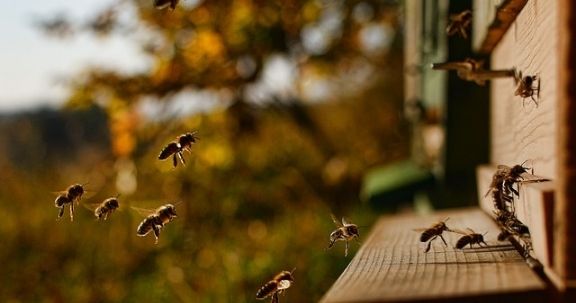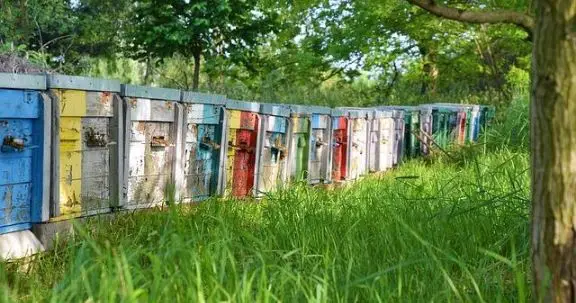So you’ve committed to beekeeping and picked out your hive style, you now have to figure out, “Where should I put my beehive?” There are actually a surprising number of factors to think about when choosing a site for your bees.

Your location may have many limitations, but even in a small space, thinking this out ahead of time may save you the headache of having to move them later or even the heartache of losing your bees. It is much easier to start with your bees in the best beehive location than having to move them later.
Legality:
- Before you get too far in the process of researching beekeeping, make sure there aren’t any local ordinances or zoning limitations on keeping bees in your area. Some outright ban beehives, others allow bees but have strict regulations about how you keep them or the number you can have in one location. You need to know these ahead of time. Check with your local town or city hall. It’s not good to work out the best beehive location and then discover you’re not allowed to keep bees in your town.
- Also, check with your state’s agricultural department to see if your state requires your bee yard (the location where you keep your beehives) to be registered.
Neighbors:
- It’s best to chat with your neighbors before you get bees. Some of them will love the idea of more pollinators in the neighborhood, some will be indifferent. It’s the folks who don’t want bees nearby that you’ll have to spend the most time talking with.
- If someone says they or a family member are allergic to bees, find out if it’s really an allergy to honey bees versus wasps or yellow jackets because their venom is different. Also find out if it’s mild local swelling and itching for a few days or if it’s a true systemic, allergic reaction. This blog is not a source of medical advice, so research this issue and talk to your doctors. If someone in your family or a neighbor’s family is actually allergic to bee stings, you need to find another location for your hives. There is a current lawsuit in my local area regarding a beekeeper and a person being stung and drowning in a neighbor’s swimming pool. You need to be sure about honey bee allergies in your family and neighbors.
- Give an unconvinced neighbor a magazine or book that explains how bees are great pollinators and may benefit their garden, especially if they grow vegetables.
- Honey is a great gift for neighbors, to keep them happy with your bees next door.
- Manage your bees to minimize swarming, as swarms may alarm neighbors. Also, educate your neighbors about the gentle nature of most swarms, ask them to keep their distance, and request they call you if they see any.
- Limit the number of hives to 2-3 at your home. You can keep more at out yards.
- If there are pets and children in your neighborhood, fence your hives. This will help keep both the bees and the little ones safe.
- Don’t work your hives if your neighbors are outside working or having a gathering.
- Work your hives in warm weather, in the middle of the day, during a honey flow. Bees become aggressive in bad weather and during dearths.
- Keep gentle bees. Requeen cranky hives.
- Neighbors can also help you in the event there’s vandalism or theft. Clearly communicate what you would like from your neighbors in that event, and communicate what you are doing to help/protect them in return.
Safety:
- Don’t keep bees near other animals or pets that are either penned or chained and could not escape from stinging insects.
- Keep your bees safe by keeping them away from cattle, horses, and bears that could rub and/or knock over hives. Electric fencing may be required if bears have been seen in your neighborhood. Once a bear raids a hive, s/he’ll be back. It’s better to prevent bear damage. I met a beekeeper who had a bear destroy his hives 3 days after he installed 2 packages. Plan ahead.
- Don’t keep hives in locations prone to flooding or fire.
- Always have a backup location worked out in the event you need to move your hives suddenly due to a neighbor, fire, property owner, or city council.
- Keep your hives painted a color that blends in either with your house/porch/building or green or brown to blend with the landscape. This is to discourage theft and vandalism of your beehives. (Avoid dark paint colors in warm climates. The hive is more likely to overheat.)
- Keep people safe from your bees by not locating hives near a path, or putting a barrier in front of the hive to alter the bees’ flight path so they have to fly out of the hive and then up over people’s heads. Tall plants, fences, evergreen hedges, and buildings can be used to alter the flight path of bees.
- Barriers to the bees’ flight paths may also work to hide hives from vandals and passers-by.
Water:

- This could be a “safety” issue to be included above, but is such a big deal it deserves its own space here.
- One hive will use 1 quart/liter of water per day and more when it’s warm out. They use a surprising amount of water. Don’t underestimate how much water they need.
- You need to have a reliable source of water ready when your first install your bees. That means, if you don’t get a water source available for them when they first move in, they’ll find somewhere else. Bees really seem to like chlorinated pool water, hot tubs, kiddie pools, and other inconvenient sources which may be on a neighbor’s property. It’s unpleasant for your neighbors to have bees collecting water while they’re trying to swim.
- The water source needs to be reliable or bees will go find another source when it’s dry, again, like your neighbor’s pool. Once they’ve switched watering sites, you can’t get them back. So even if you’re on vacation or very busy, you need to provide water for them, especially when it is hot outside. You need to provide enough water for them. This is incredibly important. Do it.
- Bees can send other bees to find water best when there’s a smell to the water, often chlorinated and sewage water attracts bees. If you are worried about a neighbor’s pool being attractive to your bees, one beekeeper I toll classes from recommends putting a 1 tablespoon of pool chlorine in 5 gallons of water for the bees, at least while they are starting to navigate your landscape and are determining their water source. You will still need to clean this water container as algae will build up.
- Bees need to be able to get in and out of the water without falling in since they don’t swim. Creeks and ponds allow bees to land and walk to the edge of the water You can offer automatic waterers sold for poultry, livestock, or pets. Rocks in shallow waterers or automatic bird waterers can give bees someplace to land and drink. You can offer a bucket or tank with corks, floating wood, or sticks to give bees a place to land. It’s good to put a hole below the rim of a bucket or tank so when it rains, the hole allows water to drain out and the floating corks and wood stay in the bucket. A hose dripping slowly on a board or rock is another good alternative. You could install a small pool and a water garden. You could fill a Boardman entrance feeder and install it on the front of a Langstroth hive.
- Remember you will have to unhook and drain automatic waterers for the winter.
- Start offering water again in the spring, as early as possible. Bees can take warm water in cool weather when they can’t take cold water. Coldwater can chill them so they can’t return to the hive. Consider a way to warm the water in cool weather. Farm supply companies often offer heated options for watering units.
- Even if you don’t have neighbors to consider, consider how close the hives are to the water source. The farther bees have to fly to collect water, the more energy inefficient it is.
- Don’t forget to water your bees. And don’t forget how much they need. Four hives = 1 gallon per day or more.
- And keep the water in the shade.